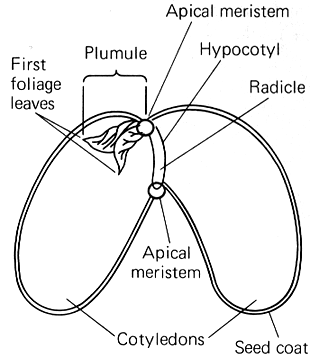Seeds & Seed Germination
Review your CD-ROMs. Look under Plants,
then pick the Topic: Reproduction
Seed: Compact, drought-resistant package consisting of an embryo (young plant),
stored food, and a tough protective covering or seed coat. Many seeds also have
special structures (feathers, hooks, or wings) to aid dispersal.

Embryo: The immature plant (shown above as apical
meristems, radicle, and hypocotyl). The embryo is usually found between the
2 cotyledons.
Cotyledons: A seed leaf (dicot seeds have 2)
which stores starch that is used as food (energy source) for the embryo as it
germinates. If the cotyledons are removed before the first leaves form, the
embryo has no source of energy (starch) & it will die.
Germination: The resumption of growth & development
by a spore or seed.
Steps in germination:
1. Seed absorbs water.
2. Metabolism begins using starch from cotyledons.
3. Other environmental signals (light, temperature, soil chemicals) stimulate
germination at correct time.
4. Gibberellins (hormone) stimulates production of enzymes to speed release
of energy from starch in the cotyledons.
5. The 2 apical meristems activate. One grows down as a root, the other
grows up to become stem and leaves.
Long & Slichter

